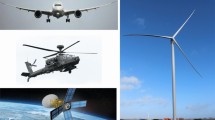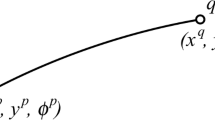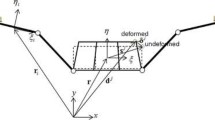Abstract
This paper presents an efficient and accurate method for dynamic stress computation based on reanalysis in flexible multibody dynamic system simulation. The mode acceleration concept that is widely used in linear strucural dynamics was utilized for accuracy improvement. A mode-acceleration equation for each flexible body is defined and the load term in the right hand side of the equation is represented as a combination of space-dependent and time-dependent terms so that efficient computations of dynamic stresses can be achieved. The load term is obtained from dynamic simulation of a flexible multibody system and a finite element method is used to compute stresses by quasi-static analyses. A numerical example of a flexible four-bar mechanism shows effectiveness of the proposed method for flexible multibody dynamic systems such as linkages and vehicle systems.
Similar content being viewed by others
References
Bisplinghoff, R. L., Ashley, H. and Halfman, R. L., 1955,Aeroelasticity, Addison-Wesley, Reading, MA.
Cornwell, R. E., Craig, Jr., R. R. and Johnson, C. P., 1983, “On the Application of the Mode-Acceleration Methods to Structural Engineering Problems,”Earthquake Engineering and Structural Dynamics, Vol. 11, pp. 679–688.
Craig, Jr., R. R., 1981,Structural Dynamics: An Introduction to Computer Methods, John Wiley & Sons Inc., New York, NY.
Craig, Jr., R. R. and Bampton, M. C. C., 1968, “Coupling of Substructures for Dynamic Analysis,”AIAA Journal, Vol. 6, pp. 1313–1319.
Craig, Jr. R. R. and Chang, C. J., 1977, “On the use of attachment modes in substructure coupling for dynamic analysis,”Dynamic & Structural Dynamics, AIAA/ASME 18th Structures, Structural Dynamics & Material Conference.
Hansteen, O. E. and Bell, K., 1979, “On the Accuracy of Mode Superposition Analysis in Structural Dynamics,”Earthquake Engineering and Structural Dynamics, Vol. 7, pp. 405–411.
Leger, P. and Wilson, E. L., 1988, “Modal Summation Methods for Structural Dynamic Computations,”Earthquake Engineering and Structural Dynamics, Vol. 16, pp. 23–27.
Liu, T. S, 1987, “Computational Methods for Life Prediction of Mechanical Component of Dynamics Systems,” Ph. D. Dissertation. The Univ. of Iowa.
Maddox. N. R., 1975, “On the Number of Modes Necessary for Accurate Response and Resulting Forces in Dynamic Analysis,”Journal of Applied Mechanics, pp. 516–517.
Nagarajan, S. and Turcic, D. A., 1990, “Lagrangian Formulation of the Equations of Motion for Elastic Mechanisms With Mutual Dependence Between Rigid body and Elastic Motion, Part I & II,”Journal of Dynamic Systems, Measurement, and Control, Vol. 112, pp. 203–224.
Sadler, J. P. an Sandor, G. N., 1973, “A Lumped Parameter Approach to Vibration and Stress Analysis of Elastic Linkages,”Journal of Engineering for Industry, Vol. 95, No. 4, pp. 549–557.
Thomson, W. T., 1972,Theory of Vibration with Applications, Prentice-Hall, Englewood Cliffs, NJ.
Turcic, D. A. and Midha, A., 1984a, “Generalized Equations of Motion for the Dynamic Analysis of Elastic Mechansim Systems,”Journal of Dynamic Systems, Measurement, and Control, Vol. 106, pp. 243–248.
Tureic, D. A., and Midha, A., 1984b, “Dynamic Analysis of Elastic Mechanism Systems, Part II: Experimental Results,”Journal of Dynamic Systems, Measurement, and Control, Vol. 106, pp. 255–260.
Williams, D., 1945, “Dynamic Loads in Aeroplanes Under Given Impulsive Loads with Particular Reference to Landing and Gust Loads on a Large Flying Boat,”Great Britain RAE Reports SME 3309 and 3316.
Winfrey, R. C., 1971, “Elastic Link Mechanism Dynamics,”Journal of Engineering for Industry, Vol. 93, No. 1, pp. 268–272.
Wu, S. C., Haug, E. J. and Kim, S. S., 1989, “A Variational Approach to Dynamics of Flexible Multibody System,”Journal of Mechanics of Structures and Machines, Vol. 17, No. 1, pp. 3–32.
Yang, Z. and Sadler, J. P., 1990, “Large-Displacement Finite Element Analysis of Flexible Linkages,”Journal of Mechanical Design, Vol. 112, pp. 175–182.
Yim, H. J. and Lee, S. B., 1996, “An Intergrated CAE System for Dynamic Stress and Fatigue Life Prediction of Mechanical System,”KSME Journal, Vol. 10, No. 2, pp. 158–168.
Yoo, W. S. and Haug, E. J., 1986, “Dynamics of Articulated Structures, Part I: Theory,”Journal of Structural Mechanics, Vol. 14, No. 1, pp. 105–126.
Author information
Authors and Affiliations
Rights and permissions
About this article
Cite this article
Ryu, J., Kim, HS. & Yim, H.J. An efficient and accurate dynamic stress computation by flexible multibody dynamic system simulation and reanalysis. KSME International Journal 11, 386–396 (1997). https://doi.org/10.1007/BF02945077
Received:
Issue Date:
DOI: https://doi.org/10.1007/BF02945077




